AUDI Q5 2015 Owners Manual
Manufacturer: AUDI, Model Year: 2015, Model line: Q5, Model: AUDI Q5 2015Pages: 302, PDF Size: 75.01 MB
Page 101 of 302

Starting the vehicle
Applies to vehicles: with hybrid drive
The vehicle is started and turned off either w ith
the ign ition key
q page 84 or with the
IS TAR T ENGINE STOP I button* ¬Ępage 87 in the
same way as a conventional vehicle .
When starting the vehicle, the need les in the in­
strument cluster
move upward br iefly. When the
vehicle enters d rive ready mode, the status mes­
sage
hybrid ready appears briefly in the instru ­
ment cluster display and the needl e in the power
meter points to READY
q page 99.
Depending on the operation mode of the hybr id
system, there are two possib le drive ready modes
after the vehicle has been started:
Drive r eady mode with combustion engine
If the ope rat ing requirements q page 101 for
e lec tric dr ive mode are
not met, the combustion
Power meter overview
Applies to vehicles: with hybrid drive
H ybri d
engine starts the vehicle as usual. You can start
driving as usual.
Drive ready m ode with th e el ectric motor
If the operating requi rements 9 page 101 for
the e lectr ic dr ive mode are met , the combustion
engi ne remains off after starting the vehicle.
(j) Tips
To p reven t the 12 volt batte ry from d ischarg­
i ng, never leave t he veh icle parked in the dr ive
ready mode. Remove the key from the igni tion
or press the
! S T AR T ENGINE ST OP I button *.
When leaving the vehicle always take the key
with you.
The power meter shows the hybrid drive condition and the availability of the hybrid system.
F ig. 1 10 Powe r meter overview
An economical dr iv ing and recuperation range is
shown in g reen . A d riving range that is not eco­
n omical is shown in o range. In addi tion, the ba t-
"' tery status provides information about the high
N
~ voltage battery charge stat us.
co
rl I.O
"' N
"' rl
@ Fuel eff icient driving with in the
combust ion engine 's pa rtial load
range
@ System limits for electric driving in
the EV mode
@ El ectric dr iving or driv ing with the
combust ion engine (EFFIC IENCY)
99
Page 102 of 302
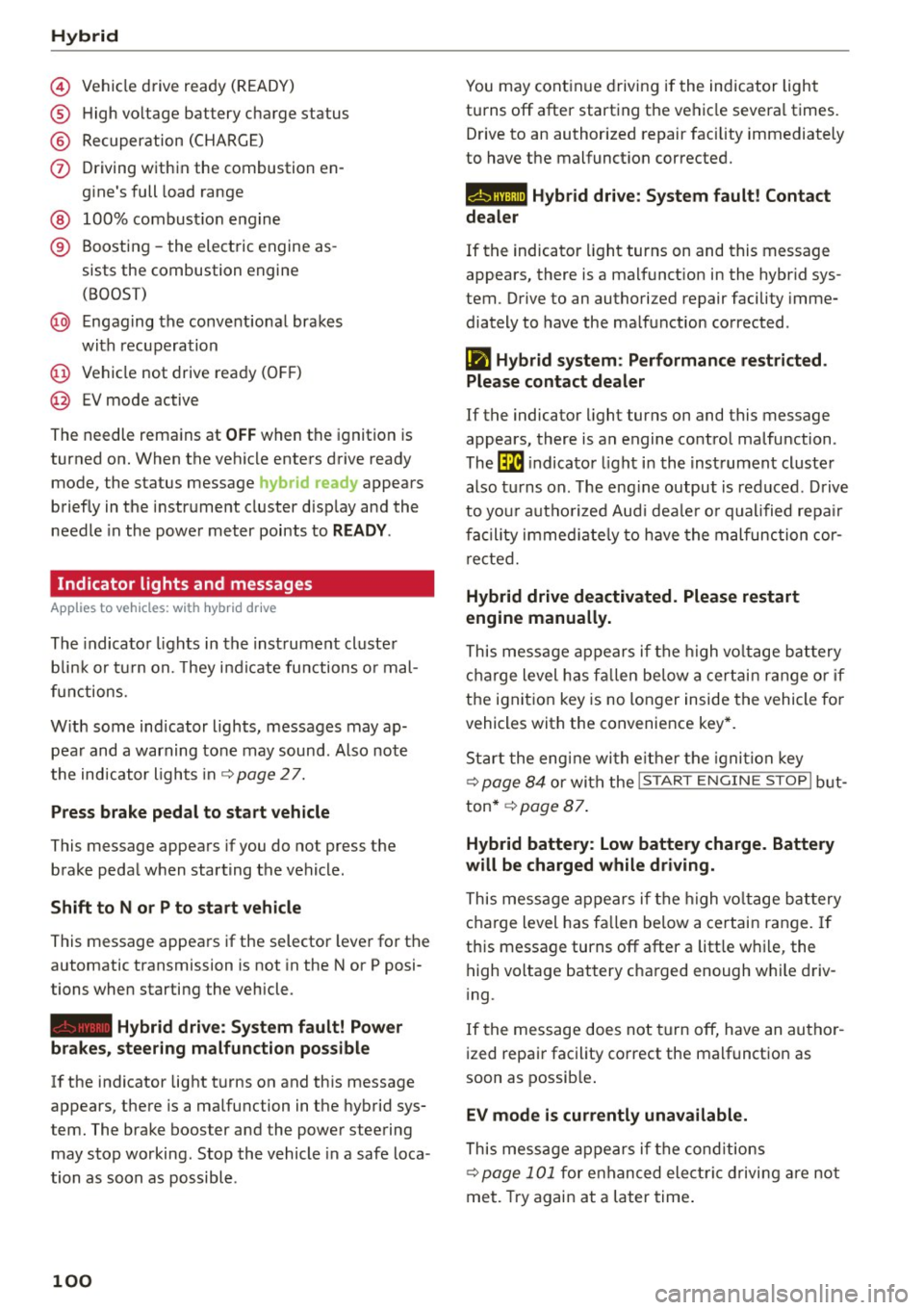
Hybrid
© Vehicle drive ready (READY)
¬ģ High voltage battery charge status
¬ģ Recuperation (CHARGE)
(f) Driving within the combustion en ­
gine's full load range
@ 100% combust ion engine
¬ģ Boosting -the electric engine as¬≠
sists the combustion engine (BOOST)
@ Engaging the convent ional brakes
with recuperation
@ Vehicle not drive ready (OFF)
@ EV mode active
The needle remains at
OFF when the ignition is
turned on. When the vehicle enters drive ready mode, the status message
hybrid ready appears
briefly in the instrument cluster d isplay and the
needle in the power meter points to
READY .
Indicator lights and messages
Applies to vehicles: with hybrid drive
The indicator lights in the instrument cluster
b lin k or tu rn on. They i ndicate functions o r mal­
functions.
W ith some ind icator lights, messages may ap­
pear and a warning tone may sound. Also note
the indicator l ights in ¬Ę
page 2 7.
Press brake pedal to start vehicle
This message appears if you do not press the
brake pedal when starting the vehicle.
Shift to N or P to start vehicle
This message appears if the selector lever for the
automatic transmission is not in the Nor P posi­
tions when starting the vehicle .
-Hybrid drive: System fault! Power
brakes, steering malfunction pos sible
lfthe indicator light turns on and this message
appears, there is a malfunction in the hybrid sys­
tem. The brake booster and the power steering
may stop working. Stop the vehicle in a safe loca ­
tion as soon as possible.
100
You may continue driving if the indicator light
turns off after starting the vehicle severa l times.
Drive to an authorized repair facility immediately
to have the malfunct ion corrected.
Q/ij:@ ,j rlybrid drive: System fault! Contact
dealer
If the indicator light turns on and this message
appears, there is a malfunct ion in the hybr id sys ­
tem. Drive to an authorized repair facility imme­
diately to have the ma lfunction corrected.
Ill Hybrid system : Performance restricted .
Please contact dealer
If the indicator light turns on and this message
appears, there is an engine control malfunction .
The
ffa i ndicator light in the instrument cluster
also t urns on. The eng ine output is red uced . Drive
to you r autho rized Aud i deale r o r qualified repair
facility immediate ly to have the malfunction cor­
rected.
Hybrid drive deactivated. Please restart
engine manually.
This message appears if the high volta ge battery
charge level has fallen be low a certain range or if
the ignition key is no longer inside the vehicle fo r
vehicles with the convenience key*.
Start the engine with e ither the ignition key
¬Ę
page 84 or with the !S TAR T EN GINE STOPI but­
ton* ¬Ę
page 87.
Hybrid battery: Low battery charge. Battery
will be charged while driving.
This message appears if the high volta ge battery
charge level has fa llen below a certain range. If
this message turns off after a litt le while, the
high voltage battery charged enough w hile driv­
i ng .
If the message does not turn off, have an autho r­
ized repair facility correct the malfunct ion as
soon as possible.
EV mode is currently unavailable.
This message appears if the cond itions
¬Ę page 101 for enhanced elect ric driving are not
met. Try again at a later time.
Page 103 of 302
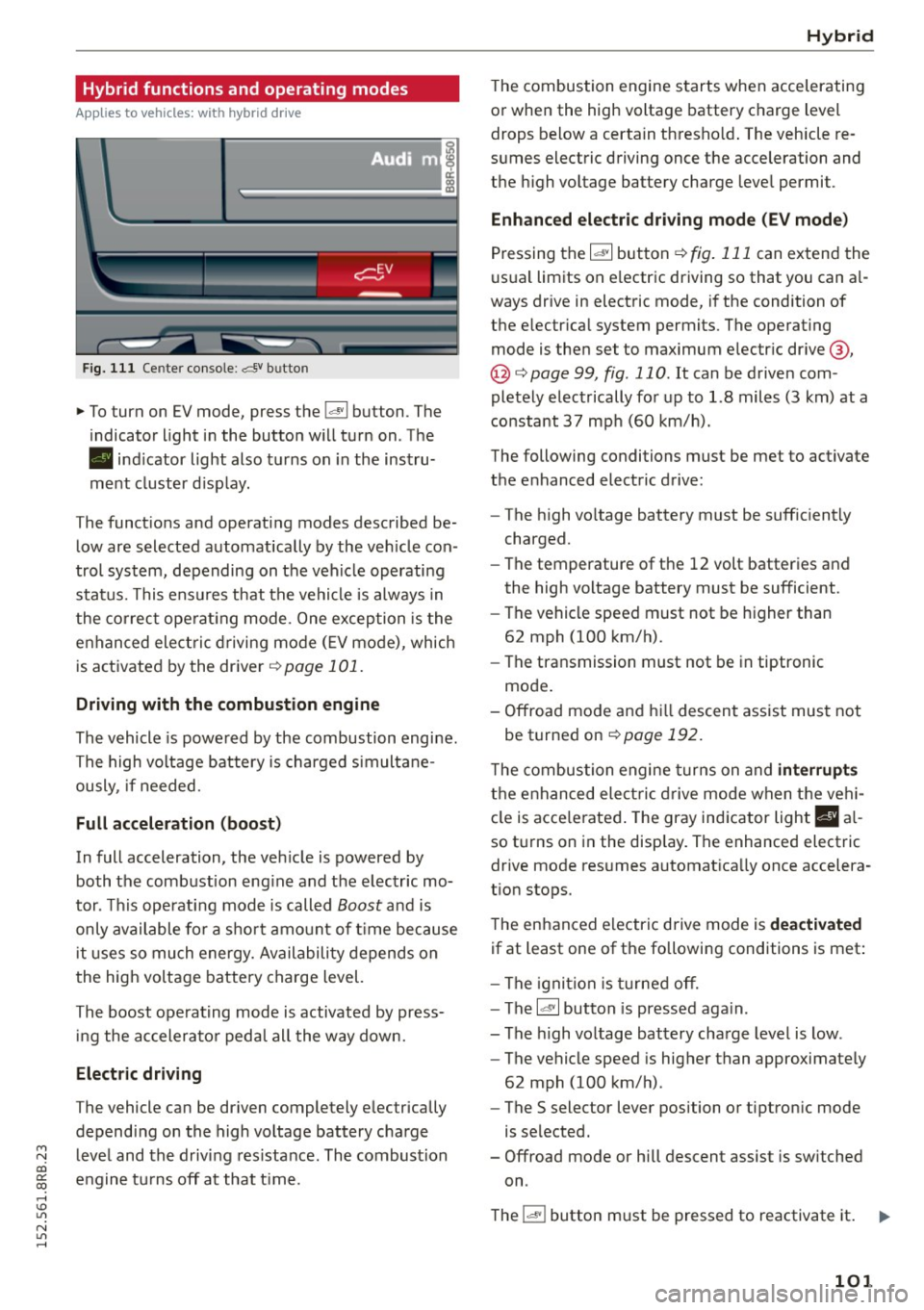
M N
co
a:
co
,...., \!) 1.1"1
N 1.1"1 ,....,
Hybrid functions and operating modes
Appl ies to vehicles: with hybri d drive
Fig. 111 Center console: av bu tton
.,. To turn on EV mode, press the l.,,;v l button. The
indicator light in the button will turn on. The
‚ÄĘ indicator light also turns on in the instru¬≠
ment cluster display.
The functions and operating modes described be­
low are selected automatically by the veh icle con­
trol system, depending on the vehicle operating
status. This ensures that the vehicle is always in
the correct operating mode. One exception is the
enhanced elect ric driving mode
(E V mode), which
is activated by the driver ¬Ę
page 101.
Driving with the combustion engine
The vehicle is powered by the combustion engine.
The high voltage battery is charged simultane­
ously, if needed.
Full acceleration (boost)
In full acceleration, the vehicle is powered by
both the combustion eng ine and the electric mo­
tor . This operating mode is called
Boost and is
only available for a short amount of time because
i t uses so much energy. Availability depends on
the high voltage battery charge level.
The boost operating mode is activated by press­ in g the accelerator peda l all the way down.
Electric driving
The vehicle can be driven completely electrically
depending on the high voltage battery charge
level and the driving res istance . The combustion
engine turns off at that t ime .
Hybrid
The combustion engine starts when accelerating
or when the high voltage battery charge level drops below a certain thresho ld. The vehicle re­
sumes electric driving once the acceleration and
the high voltage battery charge level permit .
Enhanced electric driving mode (EV mode)
Pressing the 1~· 1 button r::!> fig. 111 can extend the
usual limits on e lectric driving so that you can a l­
ways drive in electric mode, if the condition of
the electrical system permits. The operating
mode is then set to maximum electric drive @,
@ <:!> page 99, fig . 110. It can be driven com­
pletely electrically for up to 1.8 miles (3 km) at a
constant
37 mph (60 km/h).
The following conditions must be met to activate
the enhanced electric drive:
- The high voltage battery must be sufficiently
charged.
- The temperature of the
12 volt batteries and
the high voltage battery must be sufficient.
- The vehicle speed must not be higher than
62 mph (100 km/h).
- The transmission must not be in tiptronic
mode.
- Offroad mode and hill descent assist must not
be turned on
r::!;>page 192.
T he combustion engine turns on and interrupt s
the enhanced ele ctric drive mode when the vehi­
cle is acce lerated. The gray ind icator light
I§ a l­
so turns on in the display. The enhanced electric
drive mode resumes automatica lly once accelera­
tion stops.
The enhanced electric drive mode is
deactivated
if at least one of the following conditions is met :
- The ignition is turned off.
- The
l~ ·I button is pressed aga in.
- The high voltage battery charge level is low .
- The vehicle speed is higher than approximately
62 mph (100 km/h) .
- The
S selector lever position or tiptronic mode
is selected.
- Offroad mode or hill descent assist is switched
on .
The
l "'-'' I button must be pressed to reactivate it. 1iJ11-
101
Page 104 of 302
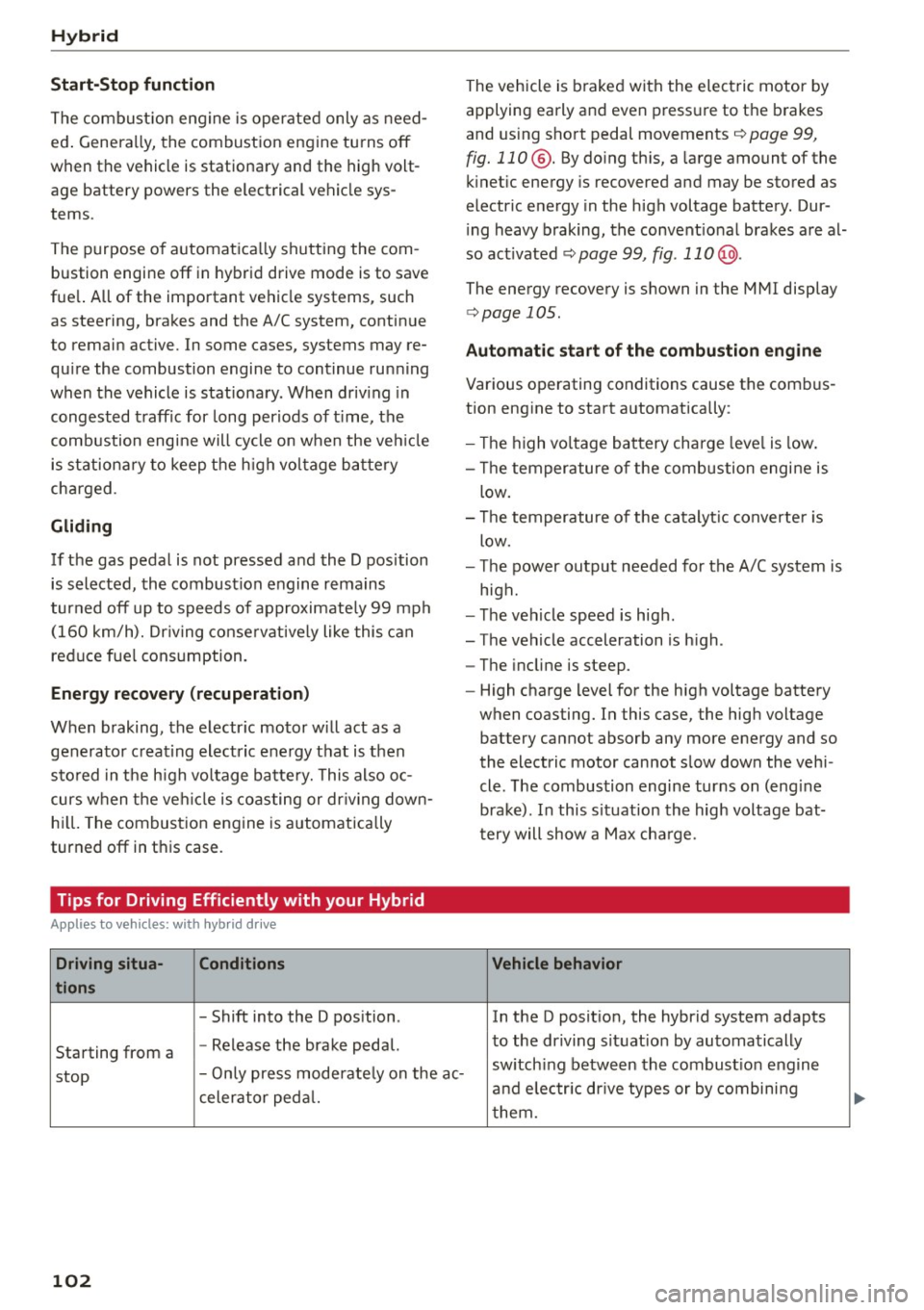
Hybrid
St art-Stop function
The combust ion engine is operated only as need­
ed . Genera lly, the combustion engine turns
off
when the vehicle is stationary and the high volt­
age battery powers the electrical vehicle sys­
tems .
The purpose o f automatica lly shutting the com­
bustion engine
off in hybrid drive mode is to save
fue l. All of the important vehicle systems, such
as steering, brakes and the A/C system, contin ue
to remain active. In some cases, systems may re­
qu ire the combustion engine to continue running
when the vehicle is stationary. When driv ing in
congested traffic for long periods of t i me, the
combustion engine will cycle on when the veh icle
is stationa ry to keep the h igh voltage battery
charged .
Gliding
If the gas pedal is not pressed and the D position
is selected, the combustion engine rema ins
turned
off up to speeds of approximate ly 99 mph
(160 km/h). Dr iving conse rvative ly like this can
r educe fue l consumpt ion.
Energy recovery (recup eration )
When braking, the e lectr ic motor will act as a
generator creating electric energy that is then
s to red in the h igh voltage batte ry. This also oc­
curs when the ve hicle is coas ting or dr iv ing down­
hi ll. The combust ion engine is automatically
turned
off in t his case.
Tips for Driving Efficiently with your Hybrid
Applies to veh icles: w ith hybrid drive
Driving situa- Conditions
tions
- Shift into the D pos ition .
Starting from a -
Release the brake pedal.
stop -
Only press mode rate ly on the ac-
celer ator peda l.
102
The vehicle is braked with the electric motor by
applying early and even press ure to t he brakes
and us ing short pedal movements¬Ę
page 99,
fig. 110@. By do ing th is, a large amount of the
k inet ic energy is recovered and may be stored as
electric energy in the high voltage batte ry. Dur ­
i ng heavy braking, the convent ional brakes are al­
so act ivated
¬Ę page 99, fig . 110 @.
The energy recovery is shown in the MMI display
¬Ępage 105 .
Automatic start of the combu stion engine
Various operating conditions cause the combus ­
tion eng ine to start a utomatica lly :
- T he high vo ltage battery charge leve l is low.
- T he temperature of the combustion engi ne is
low.
- Th e temperature of the cataly tic converte r is
low.
- T he power output needed for the A/C system is
high.
- T he veh icle speed is high .
- The vehicle acceleration is h igh .
- The incline is steep.
- High charge level for the high voltage battery
when coasting. In this case, the hig h voltage
battery cannot absorb any more ene rgy and so
the electric motor cannot s low down the veh i­
cle. The combustion engine tur ns on (eng ine
brake) . In this situation the high voltage bat­
tery will show a Max cha rge.
Vehicle behavior
In the D posit io n, the hybrid system adapts
to the driving s ituat ion by automatically
sw itch ing between the combust io n engine
a nd e lectr ic dr ive types or by combini ng
them.
Page 105 of 302
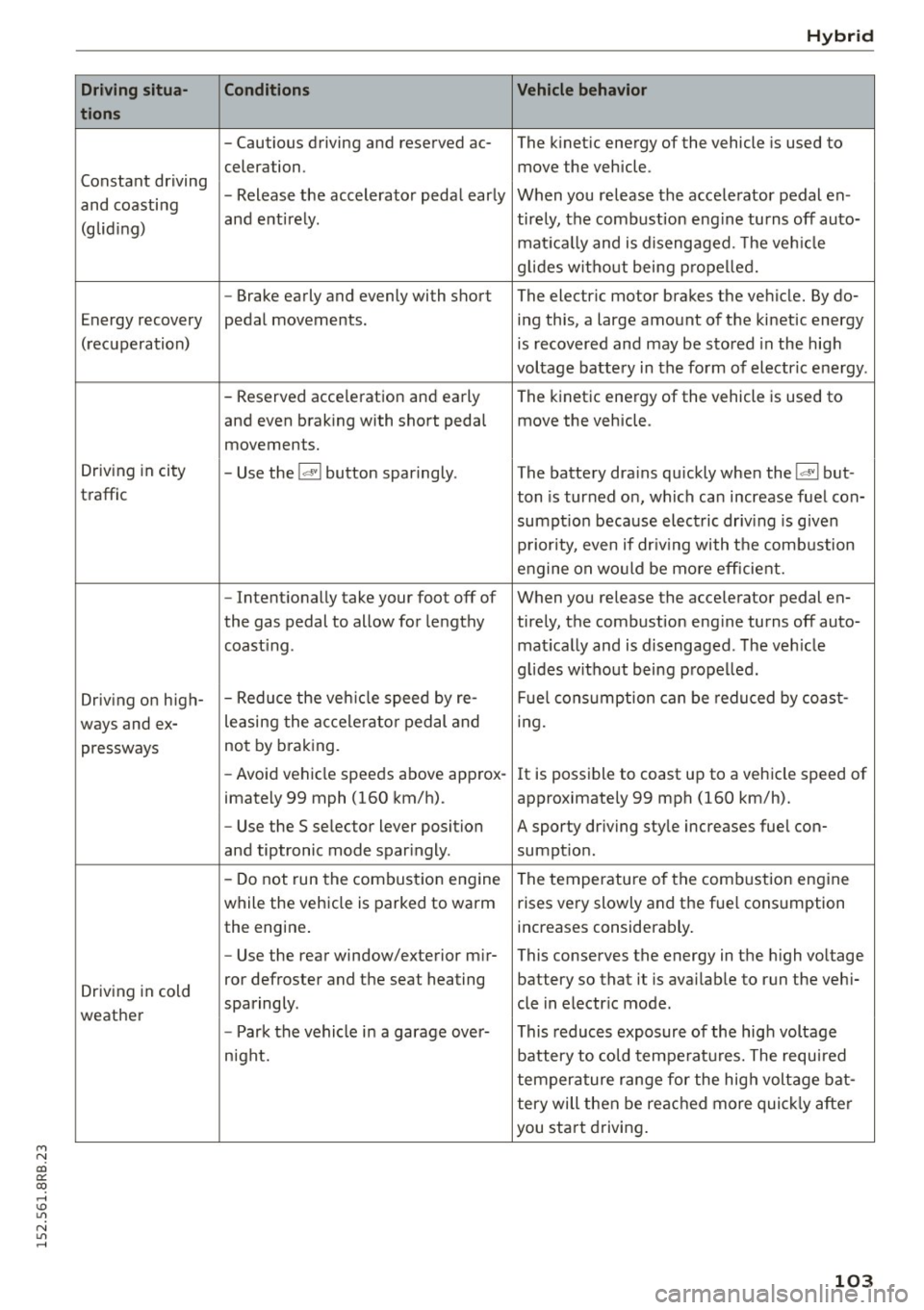
M N
co
a:
co
,...., \!) 1.1'1
N 1.1'1 ,....,
Driving situa-
tions
Constant driving
and coasting
(glid ing)
Energy recovery
(recuperation)
Driving in city
traffic
Driving on high-
ways and ex- pressways
Driving in cold
weather
Conditions
- Cautious driving and reserved ac-
celeration .
- Release the accelerator pedal early
and entirely .
- Brake early and evenly with shor t
pedal movements.
- Reserved acce leration and early
and even braking with short pedal
movements.
- Use the
!<=!VI button sparingly.
- Intentionally take your foot off of
the gas pedal to allow for lengthy
coast ing .
- Reduce the veh icle speed by
re-
leasing the acce lerato r pedal and
not by braking.
- Avoid vehicle speeds above approx-
imately 99 mph (160 km/h).
- Use the S selec tor lever position
and tiptronic mode sparingly .
- Do not run the combustion erngine
while the veh icle is parked to warm
the engine.
- Use the rear window/exterior mir-
ror defroster and the seat heat ing
sparingly .
- Park the vehicle in a garage over-
night. Hybrid
Vehicle behavior
The kinetic energy of the vehicle
is used to
move the vehicle .
When you release the accelerator pedal en-
tirely, the combustion eng ine turns off auto-
matically and is disengaged. The veh icle
g lid es without being propelled.
The electric motor brakes the vehicle. By do- ing this, a large amount of the kinetic energy
is recovered and may be stored in the high
voltage battery in the form of electric energy .
The kinetic energy of the vehicle is used to
move the vehicle .
T he battery drains quickly when the
!<=!VI but-
ton is turned on, which can increase fuel con-
sumpt ion because electric driv ing is given
priority, even if driving with the combustion
engine on wo uld be more efficient.
When you release the accelerator pedal en-
tirely, the combustion engine turns off auto- matically and is disengaged . The vehicle
g lid es without being propelled.
Fu el consumption can be reduced by coast-
ing .
It is possible to coast up to a vehicle speed of
approximately 99 mph (160 km/h).
A sporty dr iving style increases fuel con-
sumpt ion .
The temperature of the combustion engine
rises very slowly and the fue l consumption
increases considerably.
This conserves the energy in the high voltage
bat tery so that it is available to run the veh i-
cle in electr ic mode .
This reduces exposure of the high voltage
battery to cold temperatures. The required
temperature range for the high voltage bat-
tery will then be reached more quickly after
you start driving.
103
Page 106 of 302
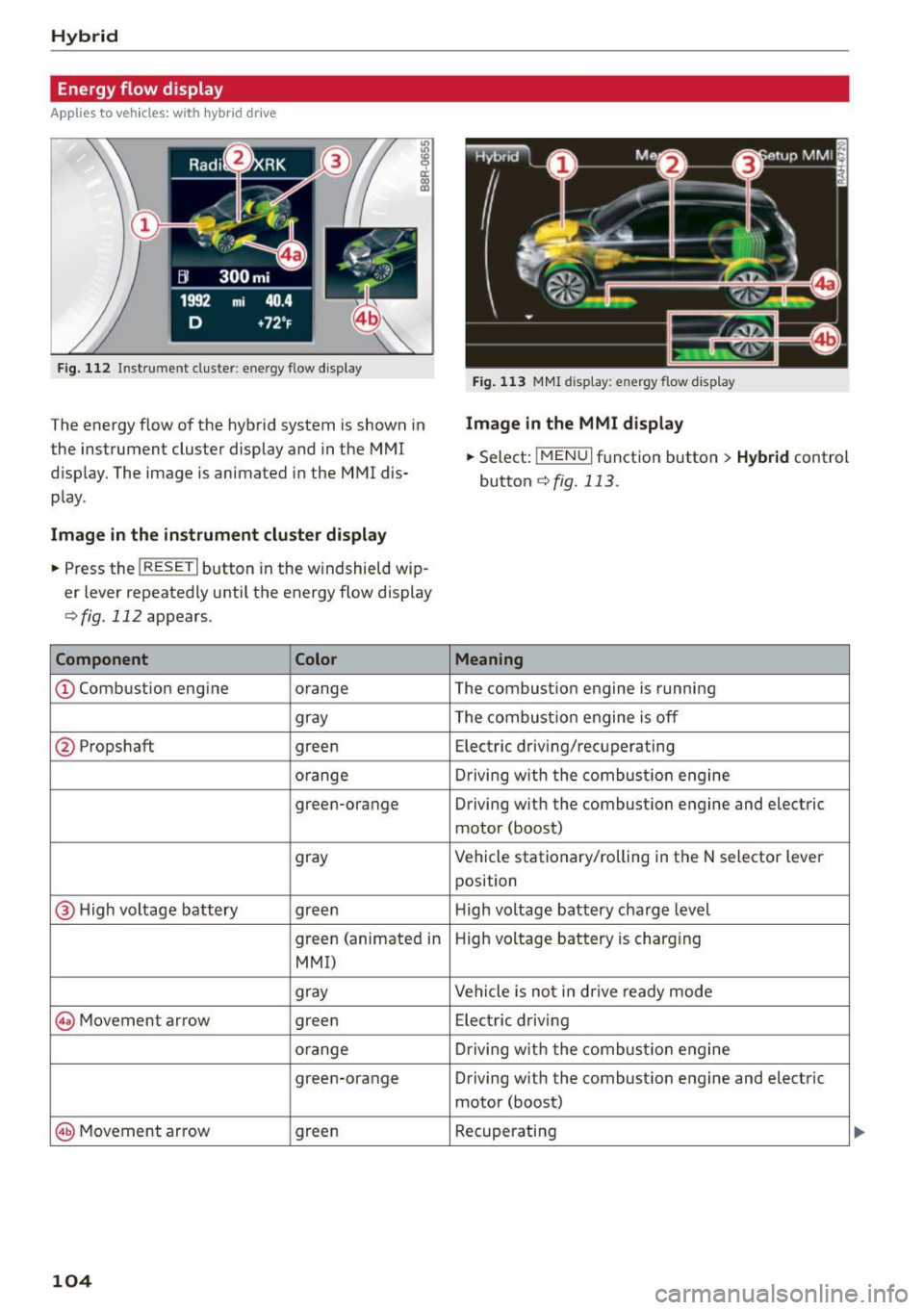
Hybrid Energy flow display
App lies to vehicles: with hybrid drive
Fig. 112 Instrument cluster: ene rgy flow display
The energy flow of the hybrid system is shown in
the instrument cluster display and in the MMI
d isplay. The image is animated in the MMI dis·
play.
Image in the instrument cluster di splay
.. Press the !RESET I button in the windshield wip ­
er lever repeatedly until the energy flow display
r::>fig. 112 appears.
Component Color
@Combustion engine orange
gray
@ Propshaft green
orange
green-orange
gray
@ H
igh voltage battery green
green (animated in
MMI)
gray
@ Movement arrow green
o
range
green-orange
@ Movement arrow green
104
Fig. 113 MMI disp lay: energy flow display
Image in the MMI display
.,. Select: I MEN u I function button > Hybrid control
button
r::!) fig. 113 .
Meaning
The combustion engine is running
The combustion engine is off
Electric driving/recuperating
Driving with t he combustion engine
Driving w ith the combust ion engine and electric
motor (boost)
Vehicle stationary/rolling in the N selector lever
position
H igh voltage batt ery charge level
High voltage battery is charging
Vehicle is not in d rive ready mode
Electric driving
Driving with the comb ustion engine
Driving with the combustion engine and electric
motor (boost)
Recuperating
Page 107 of 302

M N
co ~ co
rl I.O
"' N
"' rl
@ Tips
The Energy flow display will not shown in the
MMI display when the reverse gear is engag-
ed, due to safety reasons.
Consumption display
App lies to vehicles: with hybri d dr ive
Fig. 114 MMI display: consumptio n dis play
The consumption display shows the average ener­
gy consumption and the recuperation quantity in
5 minute intervals.
Calling up the consumption display
... Select : I MENU I function button> Hybrid control
button .
... Turn the control knob counter-clockwise .
Resetting the consumption display
... Select: I MENU I function button > Hybrid contro l
button .
... Turn the control knob to
Reset consumpt ion
statistics .
The orange bars show the average consumption
and the green bars show the recuperation quanti­
ty. Each bar represents a measured
5 minute in­
terval. The display covers a
60 minute time peri ­
od .
The bar with the white border on the outer right
shows the current average consumption or the
current recuperation quantity. After 5 minutes,
this bar travels a step to the left and a new bar
appears in the outer right.
The filled bars show the values for the current
drive cycle . Once the ignition is switched off and
on again, all of the previous bars are displayed as
Hybrid
not filled and new filled bars appear on the right.
This is so that the values from the previous trips
and the current tr ip can be compared vis ually .
Vehicle tool kit and tire repair set
Applies to vehicles: wit h hybrid drive
Fig. 115 Luggage compart ment: vehicle tool bag an d tir e
r epa ir set
The veh icle tool kit is found under a cover in the
cargo floor
~ fig . 115 @. The t i re repair set (Ti re
Mobility System) is found in the storage compart­
ment in the right s ide trim pane l@ .
Additional information about the vehicle tool kit
may be found under~
page 255 and about the
t ir e repair set under ~
page 258 .
@ Tips
The right storage compartment in the lug­
gage compartment and its contents must al­
ways be kept in the vehicle. The vehicle must
not be operated without the tire repair set.
Charging the batteries
Applies to vehicles: wit h hybrid drive
The vehicle is equipped with two 12 volt batteries
and a high vo ltage battery.
If the
12 volt batteries are dead, they may be
charged with a charger or the vehicle may be
j u mp started with assistance from another veh i­
cle in the same way as a conventional vehicle .
The same applies to the high voltage battery if it
is d ischarged . However, in this case, the charging
process is accompanied w ith messages in the in­
strument cluster display. The ignition must be
switched on and a ll unnecessary electric compo -
nents must be turned off.
ll>
105
Page 108 of 302
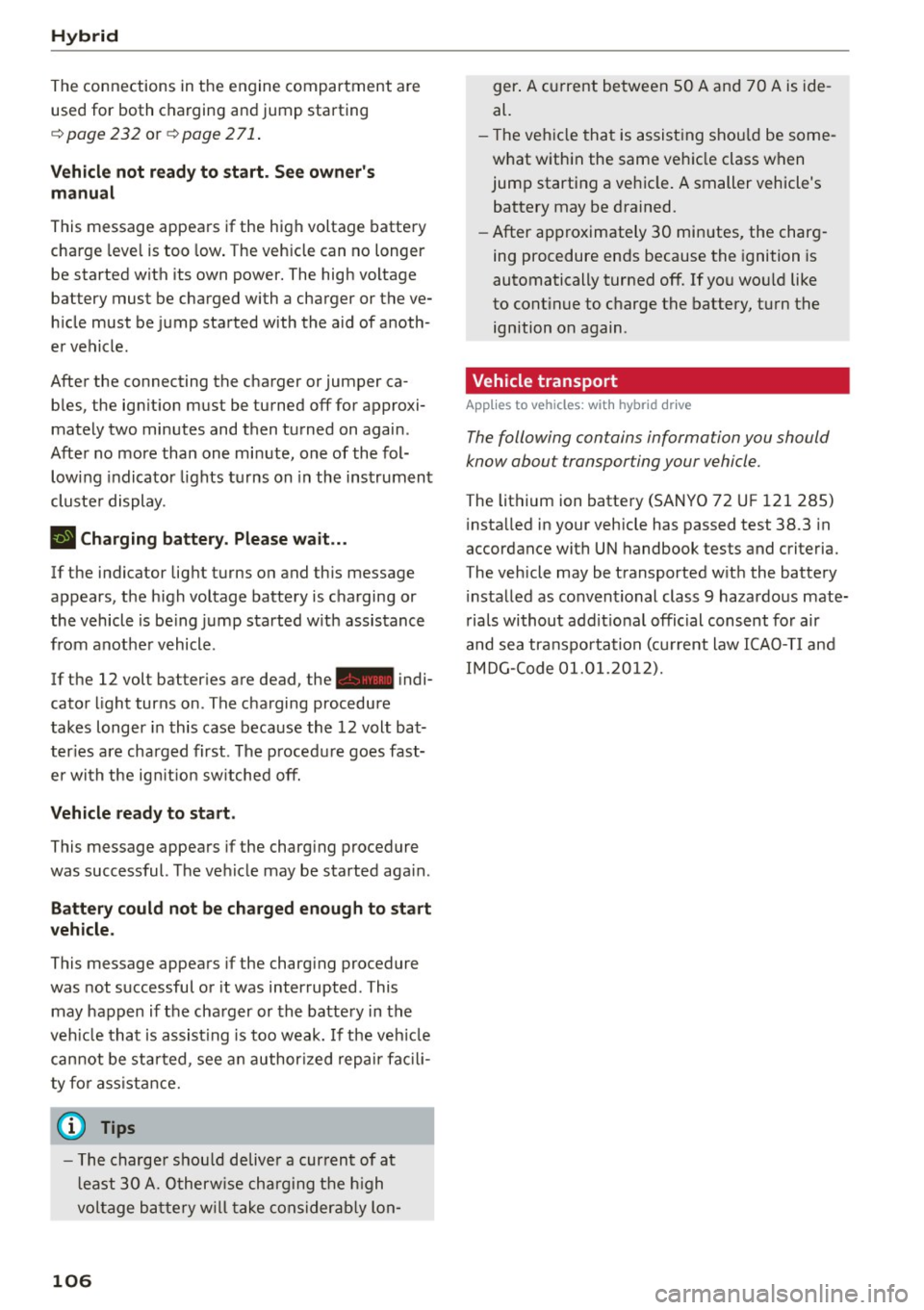
Hybrid
The connections in the engine compartment are
used for both charging and jump starting
¬Ę pag e 232 or ¬Ę page 271.
Vehicl e not r eady to start. S ee owne r's
m anu al
This message appears if the h igh voltage battery
charge leve l is too low. The vehicle can no longer
be started with its own power. The high voltage
battery must be charged with a charger or the ve­
h icle must be jump started with the aid of anoth­
er vehicle .
After the connecting the charger or jumper ca­ bles, the ign it ion must be turned off for approxi­
mately two minutes and then turned on again .
After no more than one minute, one of the fol­ lowing indicator lights turns on in the instrument
cluste r display .
B Charging battery. Plea se wait ...
If the indicator light turns on and this message
appears, the high voltage battery is charging or
the vehicle is be ing jump started w ith assistance
from another vehicle .
If the 12 volt batter ies are dead , the - indi­
cator light turns on . The charging procedure
takes longer in this case because the 12 volt bat­
ter ies are charged first . T he p rocedure goes fast­
er with the ig nition sw itched off.
Vehicle ready to st art.
This message appears if the charg ing procedure
was successful. The vehicle may be started aga in.
B atter y could n ot be ch arged en ough to st ar t
v eh icle.
This message appears if the charg ing procedure
was not successful or it was interrupted . This
may happen if the charger or the battery in the
veh icle that is assist ing is too weak. If the veh icle
can not be started, see a n author ized repair fac il i­
ty for ass istance.
(D Tips
- The charger shou ld deliver a current of at
l east 30 A. Otherw ise charging t he h igh
voltage battery w il l take considerab ly Lon-
106
ger . A cu rrent between 50 A and 70 A is ide ­
al.
- T he veh icle that is assist ing shou ld be some­
what within the same veh icle class when
jump starting a vehicle. A smaller vehicle's
battery may be drained.
- After approximately 30 minutes , the charg­
ing procedure ends because the ignition is
automatically turned off. If you wo uld like
to cont inue to charge the battery, turn the
ignition on again .
Vehicle transport
Applies to vehicles : with hybrid drive
The following contains information you should
know abou t transporting your vehicle.
The lithium ion battery (SANYO 72 UF 121 285)
i nsta lled in your vehicle has passed test 38 .3 in
accordance with UN handbook tes ts and criteria.
T he vehicle may be transported w ith the battery
i nstalled as conventional class 9 hazardous mate­
ria ls without addit ional official consent for air
and sea transpo rtation (cu rrent law !CAO-TI and
IMDG-Code 01.01.2012).
Page 109 of 302

M N
co ~ co
rl I.O
"' N
"' rl
Audi adapt ive crui se cont rol and bra king gu ard
Audi adaptive cruise
control and braking
guard
Introduction
App lies to vehicles: with Audi adaptive cruise co ntrol
The adaptive cruise control system assists the
driver by regu lating vehi cle speed and helping to
maintain a set distance to the vehicle ahead,
within the limits of the system.
If the system de­
tects a moving vehicle up ahead, adaptive cruise
control can brake and then accelerate your vehi­
cle. This helps to make driving more comfortable
on long highway stretches.
The braking guard system can warn you about an impend ing collision and initiate braking maneu ­
vers
¬Ę page 113.
Adaptive cruise control and braking guard have
technical limitations that you must know, so
p lease read this section carefu lly, understand
how the system works and use them properly at
all times.
General information
General information
A pp lies to vehicles: with Audi adaptive cruise co ntrol
Fig. 116 Fro nt of the vehicle : Position of rada r sensor
The area that contains the radar sensor
¬Ę fig. 116 must never be covered by stickers or
other objects or obs tructed with dirt, insects,
snow or ice that w ill interfere with the adaptive
cru ise control system and braking guard. For in­
formation on cleaning, refer to ¬Ę
page 208. The
same applies for any modifications made in the
front area. T
he function of the adaptive cruise contro l sys­
tem and braking guard is limited under some
condit ions:
- Ob jects can on ly be de tected when they are
within sensor range
¬Ę page 109, fig. 119.
-The system has a limi ted ability to de tect ob­
jects that are a short d istance ahead, off to the
side of your vehicle or moving into your lane .
- Some kinds of veh icles are hard to detect; for
examp le motorcycles, vehicles with high
ground clearance or overhanging loads may be
detected when it is too late or they may not be
detected at all.
- When driving through curves
¬Ępage 108 .
-Stationa ry objects ¬Ę page 108.
,&_ WARNING
-= -Always pay attention to traffic when adaptive
cruise control is switched on and braking
g uard is active. As the driver, you are sti ll re ­
sponsible for start ing and for maintaining
speed and distance to other objects. Braking
g uard is used to assist you . The drive r must
a lways take action to avo id a collision . Th e
d river is always responsible for bra kin g at the
correct t ime.
- I mproper use of adaptive cru ise control can
cau se collisions, o ther accidents and serious
pe rsonal injury.
- Neve r let the comfort and conve nience that
adap tive cr uise control and braking guard
o ff er distrac t you from the need to be alert
t o traffic con ditions and the need to remain
i n full control of your vehicle at all times,
- Always remember that the adaptive cruise
control and braking guard have limits -they
will not slow the vehicle down or maintain
the set distance when you dr ive towards an
obstacle or something on or near the road
that is not moving, such as vehicles stopped
in a traff ic jam , a sta lled or d isabled vehicle.
If registered by the radar sensor, vehicles or
obstacles that a re not moving can t rigger a
coll is io n warning and if confi rmed by the
video came ra, a n acute collision warning.
~
107
Page 110 of 302

Audi adapt ive cru ise control and brak ing gu ard
- For safety reasons, do not use adaptive
cruise control when driving on roads with
many curves, when the road surface is in
poor condition and/or in bad weather (such
as ice, fog, gravel, heavy rain and hydrop lan­
ing). Using the system under these condi­
t ions could resu lt in a col lision.
- Switch adaptive cruise control off tempora­
rily when driving in turn ing lanes, on ex­
pressway exits or in construction zones. This
prevents the vehicle from accelerating to
the set speed when in these situat ions.
- The adapt ive cr uise control sys tem wi ll not
brake by itself if yo u put you r foot on the ac­
celerator pedal. Doing so can ove rride the
speed and distance regulation.
- When approach ing stationary objects such
as stopped traffic, adaptive cruise control
will not respond and braking g uard will have
limited function.
- The adapt ive cr uise control system and brak­
ing guard do not react to people, animals,
objects cross ing the road or oncoming ob­
jects .
- The function of the radar sensor can be af ­
fected by reflective objects such as guard rails, the entrance to a tunnel , heavy rain or
ice.
- Never follow a veh icle so closely that you
cannot stop your vehicle safe ly . The adap­
t ive cru ise control cannot s low or brake the
vehicle safely when you fo llow another veh i­
cl e too close ly. Always remembe r that the
automa tic brak ing funct ion c annot bring the
vehicle to a sud den or emergency stop un­
der these conditions.
- To prevent unin tended operation, always
switch adaptive c ruise control off when it is
not be ing used .
(D Note
The sensor can be displaced by impa cts or
damage to the bumper, wheel housing and
underbody . That could affect the adaptive
cruise contro l system and braking gua rd . Have
your authorized A udi dealer or authorized
Audi Service Facility check their function .
108
In curves
Applies to vehicles: with Audi adapt ive cruise contro l
Fig. 117 Example: dri ving in to a c urve
When dr iving into a curve c:::> fig. 117 and out of a
curve, the adaptive cruise control may react to a
vehicle in the next lane and apply the brakes . You
can override or prevent the braking by pressing
the accelerator peda l briefly .
Stationary objects
Applies to vehicles: wi th Audi adaptive cruise control
Fig . 118 Example: objec t cha ngin g la n es and sta tionary
ob jec t
The adaptive cruise contro l system only reacts to
ob jects that are moving or that the system has
already detected as moving. For example, if ave­
hicle @, which has already been de tec ted by the
adap tive cruise con trol, turns or changes lanes
and another stationary veh icle @ is located in
front of that ve hicle, the system will not react to
the stat ionary vehicle.